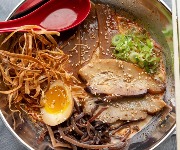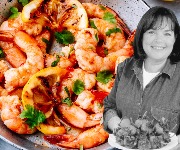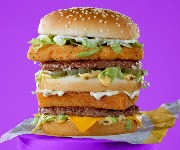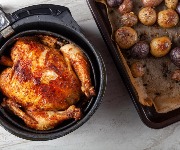Why we should be eating insects
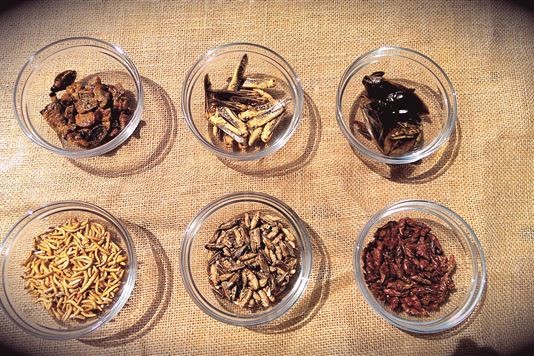
Nutritious, but are they delicious? The Lovefood team tries out some creepy-crawly critters.
According to Grub, online purveyors of freeze-dried insects for culinary purposes, 80% of the world’s nations eat insects as a part of their diet. They can be farmed in a much smaller space than large livestock, and require a substantially lower quantity of water and feed to rear to adult size.
That’s a huge number of people, who possibly haven’t had the opportunity to be picky and therefore never developed a sense that eating insects was somehow wrong, or come from cultures where bugs have historically been eaten and they just like the flavour.
When you give it some thought, thinking that they shouldn't be eaten is a fairly daft conclusion to come to. What does it matter what our food looks like, if it’s nutritious and tastes good?

Insects are, in fact, very nutritious. Crickets contain between 8-25g protein per 100g, while uncooked beef contains 19-26g, but the crickets have about a fifth of the fat and half the calories. When you look at the proportion of the animal you can eat, you find that 80% of a cricket is edible, 55% of pork and poultry is edible, but only 40% of a cow provides edible beef.
Buffalo worms contain 484 calories per 100g and 24.7g of fat. That's rather a lot of fat, you might say, and you'd be right. The high calorie count, on the other hand, means you can get away with using less of them in a dish, while still providing plenty of energy for an active lifestyle.
While this shows the value that insects could bring to our diet, the 2013 report on edible insects from the UN’s Food and Agriculture Organization (from which I am mostly drawing my figures) says that consumer acceptance remains “one of the largest barriers to the adoption of insects as viable sources of protein in many Western countries.”
Getting over the hurdle of initial disgust is paramount to introducing insect-eating as a sustainable practice. Could we put aside our kneejerk reactions and eat these wee beasties?
Normalising entomophagy
 We could have a really cheap and efficient source of protein if industrial-scale farming of insects was implemented in the UK. Chef Andy Holcroft says that there are a growing number of companies promoting entomophagy – eating insects – but they’re treating it more as a novelty item.
We could have a really cheap and efficient source of protein if industrial-scale farming of insects was implemented in the UK. Chef Andy Holcroft says that there are a growing number of companies promoting entomophagy – eating insects – but they’re treating it more as a novelty item.
The novelty value can help introduce people to edible insects in a fun and appealing manner. Yet Andy points out that insects are a “vastly untapped food source here in the west” and could provide the solution to the problem of feeding a growing global population.
Andy wants to normalise eating insects. He plans to open his restaurant, Grub Kitchen, in St Davids, Pembrokeshire in the summer. He’ll be serving up burgers, kebabs, and more – but also offering insect versions of the barbecue favourites. “You can mince up insects when they’re dried and toasted,” he explains, “and then mix them with other ingredients so that people can’t even see the insects in there.”

More than just a restaurant, he wants Grub Kitchen to be an educational experience. It will neighbour his partner Dr Sarah Beynon’s Bug Farm, where people can learn all about various kinds of bugs – then try some of them out in the restaurant, where information on nutritional content will also be up on display.
He has been in talks with policymakers and focus groups about the introduction of legislation which would allow insect farms to provide food for human consumption, and the Royal Entomology Society backing his efforts. But right now, he has to source edible insects from companies based in the Netherlands or through a friend who runs Crunchy Critters.
“The legislation in the UK is not in place for us to breed them for human consumption,” says Andy, but he hopes that when it is, the Bug Farm can be used to breed insects to supply the restaurant. The largely accepted term for the practice is ‘mini-livestock farming’.
“There will be an explosion of growth” in the UK's edible insect trade, he predicts, but that’s not going to happen until insect farming is given a green light by the Government. “It's just a matter of time,” he says though.
Taste test – what to cook?
I decided to present our team with gyoza dumplings filled with buffalo worms, Chinese greens, garlic, mushrooms and ginger. I had to be upfront about the content of the dumplings, because apparently if you’re allergic to seafood you might also be allergic to some insects.
Despite not being able to spring a surprise on the “guess what you just ate?” lines, I thought that hiding the worms themselves would help people get over the fact that they were eating worms. London-based edible insect specialist Grub (which is not affiliated with Grub Kitchen), who supplied our insects, suggest a recipe for an Asian-style salad to use with these, but I thought it best to make something a bit more shareable for the office.
However, I also offered some filling without the dumplings so those who were intrigued, and feeling brave, could try the worms at closer quarters.

For the grasshoppers, I thought that a honey roast style would fit, turning them into a snack equivalent to nuts. And as a final test, we also tried out Grub's cricket and nut fudge.

It was then time to put on a (terrible) Geordie accent and kick off our very own Bushtucker Trial…
Results
People generally liked the dumplings and said that they couldn’t really taste the worms. “It’s not slimy” said one, and suggested the worms could work very well in other dim sum. You can taste the worms in the aftertaste, another person commented, but it’s not unpleasant.

Another person said that they were slightly meaty but the flavour was heavily augmented by the garlic and ginger – “I would never identify them without looking.” So it’s possible to enjoy the food, said a third taster, while getting your protein from a source that isn’t conventional meat. “Well worth trying. Didn’t really notice the worms.”
While a couple of testers said they wouldn’t eat the filling on its own, as they could see the worms there, conversely one person said that it was “amazing” without the dumpling wrapper and wasn't bothered by the worms in the slightest.
Personally, I couldn’t really taste the worms, but if you eat them unprepared on their own, they taste a bit like cornflakes: dry, crunchy, with a slightly nutty flavour.
The grasshoppers were more popular on the whole though. They were crunchy, though not quite as crispy as expected, “delicious” according to several testers, with an “earthy taste”. Most of our tasters said they liked them, but a few were ambivalent and a couple didn’t like them – one person compared the flavour to a slightly musty tea, and said the texture is quite “dense”.

Grub says that roasting the grasshoppers with soy yields a crunchier texture than honey. However, if you like your snacks slightly sweet, the honey roast method will be up your street.
The fudge was good, but it doesn’t have that much cricket in it, so it really just tastes like nutty fudge. Nice, but not really enough insect content to give a fair verdict on what we think of crickets.
Would you be willing to try eating insects? Could you be convinced to give them a go if the insect content of your food wasn’t so obvious? Let us know in the Comments below.
You might also like:
Most Recent
Comments
Be the first to comment
Do you want to comment on this article? You need to be signed in for this feature
